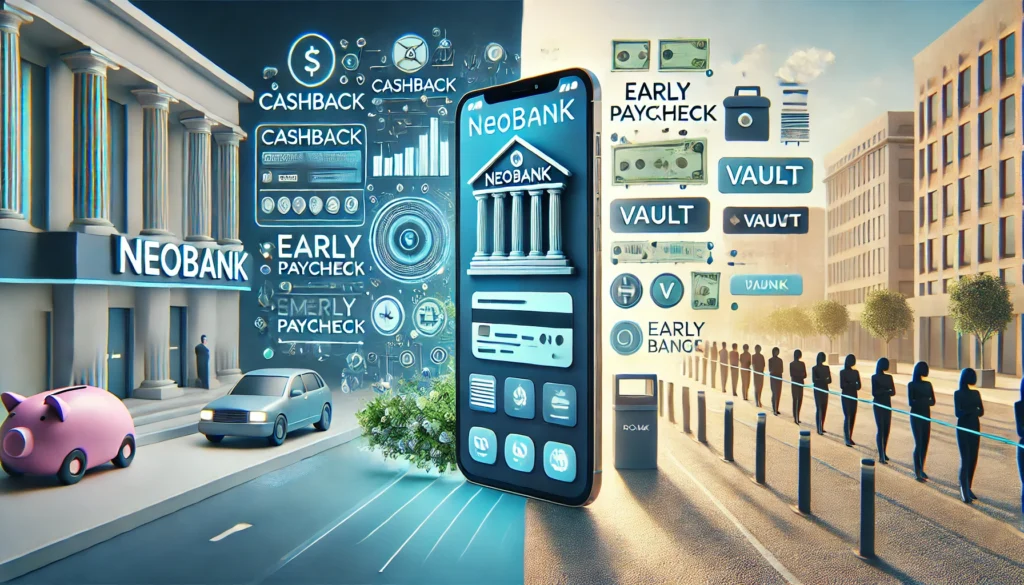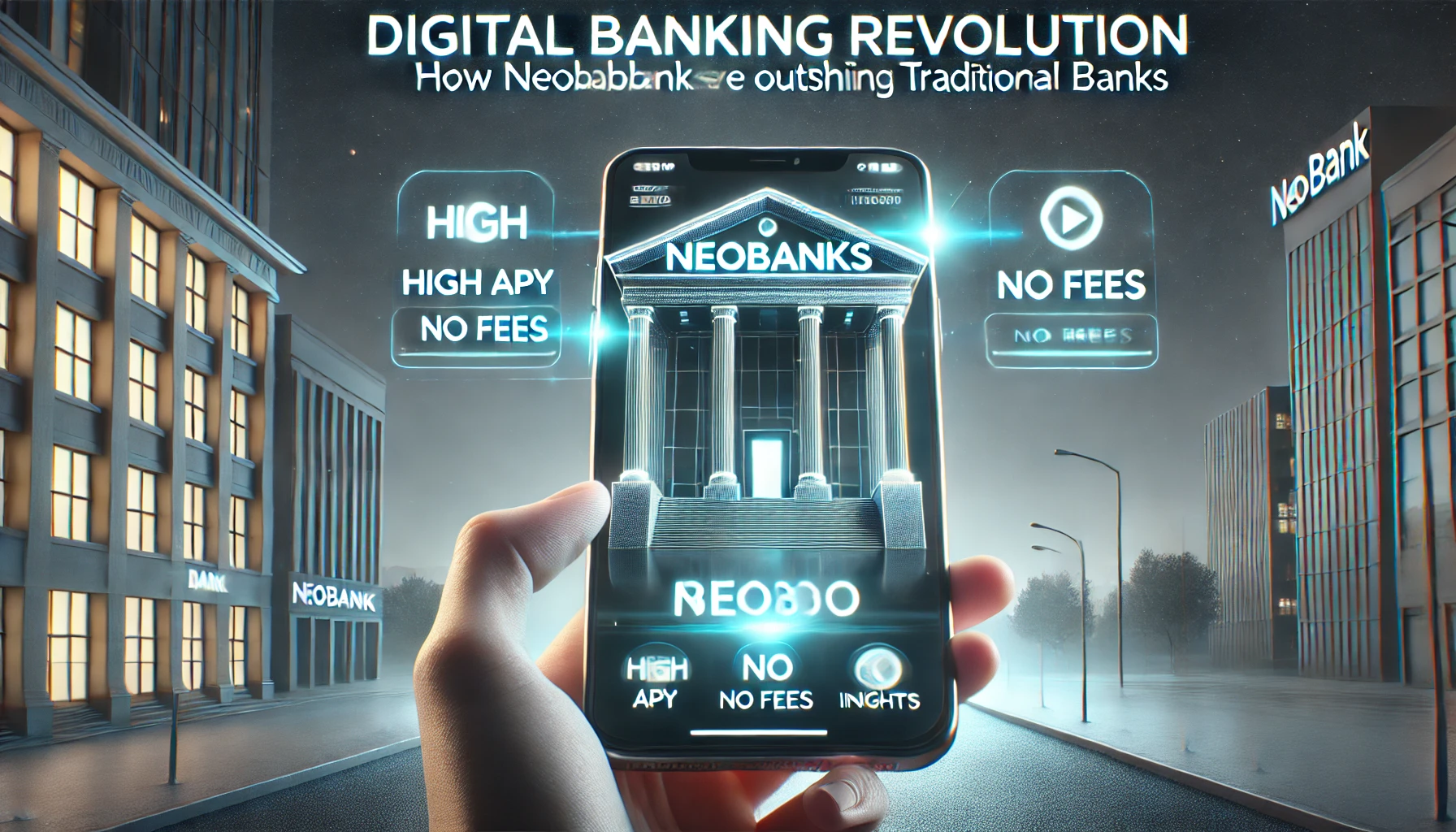Introduction: The Dawn of Digital-Only Banking
The financial world is undergoing a seismic shift as digital-only banks (neobanks) rapidly gain traction, offering a modern alternative to traditional banks. With no physical branches, lower fees, and cutting-edge features, digital-only banks advantages like those offered by neobanks such as Chime, Revolut, and Varo are redefining personal finance management for millions.
By 2025, neobanks are projected to hold over 20% of the global banking market, signaling a permanent change in how we interact with money. This article dives into the advantages of digital-only banks, compares neobank vs. traditional bank features, and explores how they’re transforming personal finance for the better.
Why Neobanks? The Key Advantages of Digital-Only Banking

1. Lower Fees, Higher Savings (A Major Win for Consumers)
One of the biggest draws of digital-only banks is their cost efficiency. Without the overhead of physical branches, neobanks pass savings onto customers through:
No monthly maintenance fees (unlike many traditional banks)
Higher interest rates on savings (some offer 5% APY or more)
No overdraft fees (Chime and others eliminate them entirely)
Free ATM access (through large networks like Allpoint)
Example: Varo Bank offers 5.00% APY on savings—far above the 0.01%-0.05% from many legacy banks.
2. Lightning-Fast, Mobile-First Banking
Neobanks prioritize speed and convenience, offering:
📱 Instant account setup (open an account in minutes)
💳 Real-time transaction alerts (no more waiting for updates)
📸 Mobile check deposit (just snap a photo)
⏳ Early direct deposit (get paid up to 2 days sooner)
Unlike traditional banks, which often require in-person visits for basic services, neobanks operate 100% digitally—perfect for today’s on-the-go lifestyles.
3. Smart Money Tools That Traditional Banks Can’t Match
Neobanks leverage AI and automation to provide features like:
Automatic savings (round-ups, scheduled transfers)
AI-powered budgeting (track spending in real time)
Credit-building tools (Chime’s Credit Builder helps boost scores)
Cashback rewards (some offer up to 10% back on purchases)
Example: Revolut’s “Vaults” feature lets users automatically stash spare change into savings—something most traditional banks still don’t offer.
4. Transparency & Customer-Centric Design
Frustrated with hidden fees? Neobanks thrive on clarity:
No surprise charges (unlike traditional banks’ complex fee structures)
Simple, intuitive apps (designed for ease of use)
24/7 customer support (via chat or in-app messaging)
This customer-first approach is why millennials and Gen Z are flocking to neobanks—they’re tired of outdated banking practices.
Neobank vs. Traditional Bank: A Side-by-Side Showdown
| Feature | Neobanks 🚀 | Traditional Banks 🏦 |
|---|---|---|
| Physical Branches | ❌ None | ✅ Extensive network |
| Account Setup | ⚡ Minutes, fully digital | ⏳ Often requires in-person visits |
| Monthly Fees | 💰 Usually $0 | 📉 Often 5−5−15+ |
| Savings APY | 📈 Up to 5%+ | 📉 Often <0.05% |
| Overdraft Fees | 🚫 Typically none | 💸 $35+ per incident |
| Customer Support | 💬 Chat/email only | ☎️ Phone & in-person |
| Innovation | 🔥 AI budgeting, automation | 🐢 Slow to adapt |
Verdict: If you want lower fees, better tech, and faster service, neobanks win. But if you prefer in-person help or need complex loans, traditional banks still have a role.
How Neobanks Are Transforming Personal Finance

1. Banking the Unbanked (Financial Inclusion Matters!)
Neobanks are democratizing finance by serving:
🌎 Immigrants (some accept alternative IDs)
👶 Teens & young adults (early financial literacy tools)
💳 Those with poor credit (no credit checks for basic accounts)
Example: Nubank in Brazil has onboarded millions of first-time bank users.
2. Forcing Traditional Banks to Innovate (Finally!)
Legacy banks are now scrambling to improve their digital experiences—thanks to neobank competition. Many now offer:
Better mobile apps
Fee-free accounts
Faster transfers
3. Making Money Management Actually Fun (Yes, Really!)
With gamified savings, real-time spending insights, and personalized tips, neobanks are making finance more engaging than ever.
Example: Monzo’s “Pots” feature lets users visually track savings goals—a far cry from outdated paper statements.
4. Global Banking Without the Headaches
For travelers, expats, and freelancers, neobanks like Wise and Revolut offer:
🌍 Multi-currency accounts
💸 Low-cost international transfers
💳 No foreign transaction fees
The Future of Neobanking: What’s Next?
🔮 AI-powered financial advisors (hyper-personalized money tips)
🌱 Green banking (sustainable investing options)
🤖 Voice-activated banking (“Hey Alexa, send $50 to Mom”)
🔄 Banking-as-a-Service (BaaS) (embedded finance in apps)
Final Verdict: Should You Switch to a Neobank?
✅ Yes, if you want: Lower fees, better tech, and a seamless mobile experience.
❌ No, if you need: In-person services, mortgages, or complex investments.
Either way, digital-only banks are here to stay—and they’re pushing the entire banking industry forward.
Ready to try a neobank? Check out top picks like Chime, Revolut, or Varo and see how they compare to your current bank!
🔗 Further Reading:
The bottom line? Neobanks are winning the finance game—one digital feature at a time. 🚀💳
For more information on the world of digital banking go check out our post on Neobanks vs. Traditional Banks: Which One is Better for you in 2025



